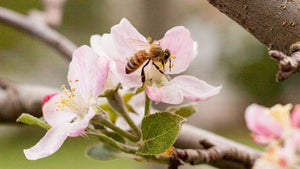Item Number: FT025
Cox Orange Pippin Apple Tree
The gold standard of heirlooms.
Cox Orange Pippin is an iconic heirloom apple variety, celebrated for its complex sweet-tart flavor and crisp, aromatic flesh. The medium-sized fruit features a golden skin with orange-red striping, adding visual appeal to its exceptional taste. Perfect for fresh eating, gourmet desserts, or cider-making, . The tree thrives in full sun and well-draining soil, requiring moderate chill hours. Cox Orange Pippin benefits from a pollinator, such as Golden Delicious or Dwarf Honey Crisp, for abundant yields. With its rich history and outstanding flavor, this variety is a must-have for gardeners seeking an heirloom treasure.
Dwarf on M-111 rootstock.
Chill Requirements: Flourishes with 800 chill hours.
Bloom Time: Typically blooms late, aligning with Central Valley California's weather pattern.
Harvest Season: Expect ripe fruits between September and early October.
Visual Aspects:
The apple exhibits an enticing appearance, transitioning from orange-red to bright-red hues over a yellow base.
Flavor and Attributes:
Personality-wise, it offers firmness, juiciness, and a noteworthy sweetness, rich in flavor with a distinctive aroma.
This heirloom apple variety doesn't carry a tartness, making it an excellent choice for dessert consumption.
It's an Old English dessert apple that made its debut in 1825, praised for its flavor and versatility. Ideal for cider and fresh eating.
Noteworthy Facts:
This apple thrives in moderate climates, preferring conditions that aren't extreme.
Cox Orange Pippin demonstrates its fruiting prowess, yielding its first harvest in just two years.
Pollination Requirements:
While it can self-pollinate in certain climates, optimal fruit set is often achieved with a pollinating variety nearby.
Historical Significance:
Renowned historical figures like Thomas Jefferson and George Washington had a penchant for apple-growing, with Jefferson documenting his enthusiasm for the Newtown Pippin.
The Newtown Pippin, a yellow-green apple originating from Long Island, was presented by Andrew Stevenson, an American Minister, as a gift to Queen Victoria.
The Albemarle Pippin, hailing from Albemarle County, Virginia, was a cherished 18th-century American apple variety.
Growing Pippin apples is an homage to an illustrious past and a testament to the enduring legacy of these apples in the United States. With their rich history and exceptional flavors, these trees continue to captivate orchard enthusiasts and apple lovers alike.
Visit our Fruit Tree Central for a listing of all our fruit tree videos and articles.
Visit Tree Characteristics for a listing of all our fruit & nut tree growing characteristics.
For more information about different types of rootstocks and how they influence tree size and growth, see our Tree Rootstock Characteristics Chart.



Check Your Zone Compatibility:
Compatible with your zone.
Growing Zone for

Our Guarantee To You
Since 1976, we've served our customers at every stage of growing. Please contact us at any time. We are happy to support and assist you.
Shipping Information
Shipping Information
Cannot ship to the following states: HI, AK, PR, GU, VI
Shipping Weight: 5.0 lb
Dimensions: 47.5"L x 7.3"W x 2.75"H
Features
Features
- Bare Root
- Self-fruitful
Characteristics
Characteristics
Planting & Care
Planting & Care
Useful Information
Useful Information
Guarantee
Guarantee
Limited Dormant Tree & Plant Guarantee
* Claim deadline is June 15th
We guarantee that your dormant tree or plant will arrive in good, viable condition. If your tree arrives in substandard condition, notify us within 3 days of delivery. Please email pictures of the box, inside packaging, the tree and its roots to helpdesk@groworganic.com. We will investigate your claim and process a request to exchange or refund the damaged product.
If your dormant tree or plant has not grown new leaves by June 15th, you may be eligible for our Limited Dormant Tree & Plant Guarantee. This guarantee provides for a store credit for the purchase price of the tree, excluding shipping. Please see the Instructions below.
Important Dates:
- April 1st Dormant trees/plants must be planted in the ground
- May 15th Perform scratch test, if no new leaves have grown
- June 15th Deadline to apply for a dormant tree/plant credit
All required documentation must be received by June 15th for your claim to be considered. Claims or documentation received after June 15th will be denied, without exception. Instructions listed below
Terms and Conditions
We cannot guarantee that your tree or plant will remain alive and healthy after it is received, or bear fruit as there are too many variables in your environment that are beyond our control (i.e. soil preparation, weed and pest control, proper irrigation, chill hours, compatible hardiness for your growing zone, proper choice of pollinator, extreme weather, rodent damage, disease, etc.).
We cannot guarantee that we will be able to provide a replacement tree/plant of the same species either that same growing season or in future years. Customers are responsible for all shipping fees associated with replacement trees and plants.
If we determine that the tree you purchased directly from us is not viable, we will issue you a store credit (not a refund) for the purchase price of the affected dormant tree or plant. Shipping is not included in the dormant tree/plant guarantee. Store credits can be used to purchase any product we sell and are valid for use only until July 1st of the following year.
Historically, 98% of our dormant trees and plants grow and thrive when they have been cared for and planted using our growing guides. Dormant trees and plants must be planted in the ground by April 1st in order to be eligible for credit. If the ground in your area is still frozen solid, you may temporarily plant your tree or plant in a pot.
Potted, non-dormant trees or plants are excluded from this guarantee as they are not dormant at the time of shipment. Evergreen trees such as citrus, avocado and olive trees are not available for credit under the Dormant Tree and Plant Guarantee.
Instructions
We guarantee that your dormant fruit tree or plant will leaf out, if you care for it according to our growing guides. In the unlikely event that your dormant tree or plant does not have leaves by May 15th, follow these simple steps to apply for a store credit:
Before you call or email, please perform a “scratch test” to determine if the tree or plant is still alive. This video shows how to check for live tissue under the bark. Scratch tests need to be done a few inches above and below the graft.
Green Cambium Layer / Living Trees
If the cambium layer under the bark is green, give your tree a little more time. It is still alive, but hasn’t come out of dormancy yet. Check to make sure that it is getting the right amount of deep root water, enough sunlight and that the weather is warm enough for that type of tree/plant to come out of dormancy. Every tree has its own personality and will come out of dormancy at different times. Be sure to submit the required documentation listed below by June 15th, if it doesn’t grow leaves.
Brown Cambium Layer / Dead Trees
If the scratch test shows a brown cambium layer or if your dormant tree/plant doesn’t have leaves by June 1st, please email us at helpdesk@groworganic.com. All required documentation listed below must be received by June 15th for your claim to be considered. To be considered for the guarantee claim, all required documentation must be received by June 15th. Incomplete submissions will be denied.
Required Documentation
- Order number
- Name of dormant tree/plant and the quantity affected
- Photos of each tree or plant showing:
- The roots (tree or plant must be pulled out of the ground)
- The scratch test areas
- The entire tree/plant
We reserve the right to not issue credit for items that have already been replaced. We also reserve the right to require photographic evidence that the tree/plant was not killed by root rot, rodent or mechanical damage.
Share




Best place to buy fruit trees and seeds. Thank you!
I planted several apple trees of different varieties in 2021. This was the first of them to produce apples. I had quite a few immature ones fall off, but it produced 8 full sized apples in 2022. They didn't have as much red on them as the Cox's Orange Pippin apples I was used to seeing from the UK, but tasted fairly similar. They were somewhat larger and slightly less sweet, although still really good. They are decidedly better than anything you can get at the store around here, with the possible exception of Cosmic Crisps. It will be interesting to see what the next year is like. One thing to note, these supposedly ripen in early fall but for me here in the Willamette Valley they didn't taste fully ripe until November. Will try to remember to report back in future years. The tree itself is growing fantastically, I'm super happy with it.







